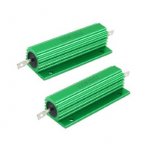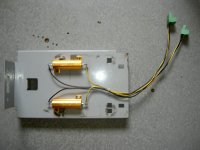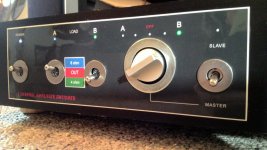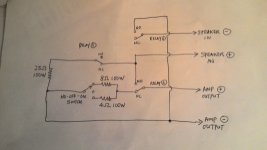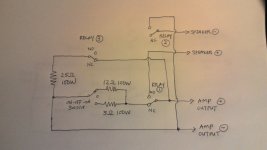I want to build a amplifier switcher for my friend to compare his tube amps ( switching two amplifiers with one pair of speaker ).
Is a 25 ohm dummy loading resistor safe for ANY tube amp? or I need a higher/lower value resistor?
Your advise would be most appreciated.
Is a 25 ohm dummy loading resistor safe for ANY tube amp? or I need a higher/lower value resistor?
Your advise would be most appreciated.
Is a 25 ohm dummy loading resistor safe for ANY tube amp? or I need a higher/lower value resistor?
There's always a quirky amp around, but I'd use a non-inductive resistor equal to the impedance tap
that is being used (with enough power rating), like 8 ohms on the 8 ohm tap, etc.
Also have a higher value (like 100 ohms) permanently connected directly across the output of all
of the amp channels to avoid open circuits.
Thanks for your input, rayma
What is the reason to use non-inductive resistor and why the resistor to be matched with the amp output impedance?
What is the reason to use non-inductive resistor and why the resistor to be matched with the amp output impedance?
It doesn't really need to be non-inductive - a speaker is not non-inductive!
It should be not too different from the intended load impedance, especially if you are driving to full output. It is there to load the OPT so when clipping takes place with the valve switched off by grid drive and the OPT self-resonates the stored energy has somewhere safe to go.
Don't switch with signal present.
It should be not too different from the intended load impedance, especially if you are driving to full output. It is there to load the OPT so when clipping takes place with the valve switched off by grid drive and the OPT self-resonates the stored energy has somewhere safe to go.
Don't switch with signal present.
Thanks for your input, rayma
What is the reason to use non-inductive resistor and why the resistor to be matched
with the amp output impedance?
The non-inductive type is similar in price to others, and is potentially useful as an amp test load.
Some tube amps could be damaged if operated with a load impedance much different from the rated.
The ones you have will be fine, though. Bear in mind that the resistor's rated power only applies
if they are mounted on a heat sink.
Last edited:
I use these. Three in parallel on each channel for 60w.
6X 24 Ohm 20 Watt Non Inductive Load Power Resistor New | eBay
6X 24 Ohm 20 Watt Non Inductive Load Power Resistor New | eBay
Non iductive power esistors? Use these fixed on a heatsink and at half the mentioned power.
MP9100-1.00-1% | Caddock MP9100 Series TO-247 Radial Power Film Resistor 1Ω 1% 100W -20 → +80ppm/C | Caddock
AP101 2R F 300PPM | Arcol AP101 Series TO-247 Axial High Power Resistor 2Ω 1% 100W 300ppm/C | Arcol
These are available in values ranging from 1 Ohm to ...
Max power 100W but read the spec sheet and apply no more then 50W.
I use them on my dummy load (up to 800Watts) on computer processor heatsinks with a temp controlled ventilator.
MP9100-1.00-1% | Caddock MP9100 Series TO-247 Radial Power Film Resistor 1Ω 1% 100W -20 → +80ppm/C | Caddock
AP101 2R F 300PPM | Arcol AP101 Series TO-247 Axial High Power Resistor 2Ω 1% 100W 300ppm/C | Arcol
These are available in values ranging from 1 Ohm to ...
Max power 100W but read the spec sheet and apply no more then 50W.
I use them on my dummy load (up to 800Watts) on computer processor heatsinks with a temp controlled ventilator.
Thank you everybody's idea on dummy load resistor, those TO-247 resistor are great space saving component although I don't need 1% precision and a bit costly for my application.
The schematics shows that it will break before make, thus for a moment leaving the amp
without load. Not good.
Adding a permanent 100ohm 5w resistor on the amp side will however keep the amp (somewhat) loaded while not degrade performance much.
without load. Not good.
Adding a permanent 100ohm 5w resistor on the amp side will however keep the amp (somewhat) loaded while not degrade performance much.
200W 4ohm Aluminium Shell Braking Resistor Resistance Dummy Load for Audio | eBay
Tolerance +-5%, 40W without heat sink. I mount a pair back to back and the speaker plug is connected directly to wire lead, for very quick manual switching between the speaker and dummy. If your amp has gNFB, it's probably ok without a load, because gNFB has to clamp down the output when unload, but if zero feedback must have a load.
Tolerance +-5%, 40W without heat sink. I mount a pair back to back and the speaker plug is connected directly to wire lead, for very quick manual switching between the speaker and dummy. If your amp has gNFB, it's probably ok without a load, because gNFB has to clamp down the output when unload, but if zero feedback must have a load.
Sorry I didn't make it clear, the 25 ohm resistor is " kind of " permanent.
When the selector at "off" position, 25ohm resistor parallel with the 12 ohm or 5 ohm resistor to form a load close to 8 or 4 ohm load on the amplifier terminals.
When the selector at the position between "off" and "A", relay 1 and 2 connect amplifier to speaker while the 25 ohm resistor still in the circuit.
When the selector turn to "A" position, relay 3 will turn on and disconnect the 25 ohm resistor from the circuit.
Relay 1 and 2 are 40/60A SPDT automotive relays, four needed per channel. I also added a MY4Z Omron relay parallel to the contacts.
When the selector at "off" position, 25ohm resistor parallel with the 12 ohm or 5 ohm resistor to form a load close to 8 or 4 ohm load on the amplifier terminals.
When the selector at the position between "off" and "A", relay 1 and 2 connect amplifier to speaker while the 25 ohm resistor still in the circuit.
When the selector turn to "A" position, relay 3 will turn on and disconnect the 25 ohm resistor from the circuit.
Relay 1 and 2 are 40/60A SPDT automotive relays, four needed per channel. I also added a MY4Z Omron relay parallel to the contacts.
Attachments
I use an 8 ohm 10 watt resistor in a glass of water. Works great.
The KISS way. Good!🙂
I use an 8 ohm 10 watt resistor in a glass of water. Works great.
Over time electrolysis may weaken the leads where they enter the resistor causing sudden and unexpected failure, and just as a general rule I try to keep water and electricity apart.
I've used heavy mineral oil, the kind you can buy at a pharmacy (in the US anyway) in exactly the same way. Just make sure it doesn't get too hot. This is also a great trick for running resistors WAY over their rated voltage, since surface arcing is the usual mode of failure. Same trick with variable capacitors, except the capacitance changes of course. (And yes, I was a HV spark throwing nut for several years, there's nothing quite like a Marx generator to convince your kid that you are a mad genius, and that they should stay away from your work area...)
Yes, KISS is good, but automotive relay are so cheap and easy to replace compare to a switch.The KISS way. Good!🙂

- Status
- Not open for further replies.
- Home
- Amplifiers
- Tubes / Valves
- Dummy load for tube amp
